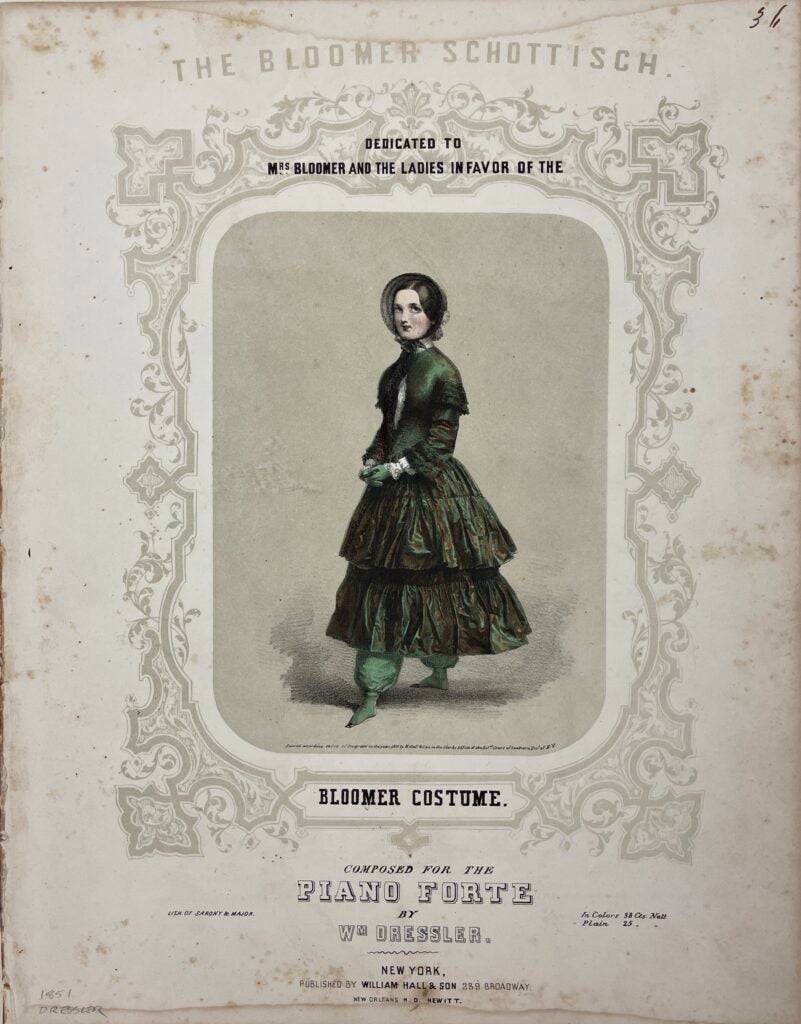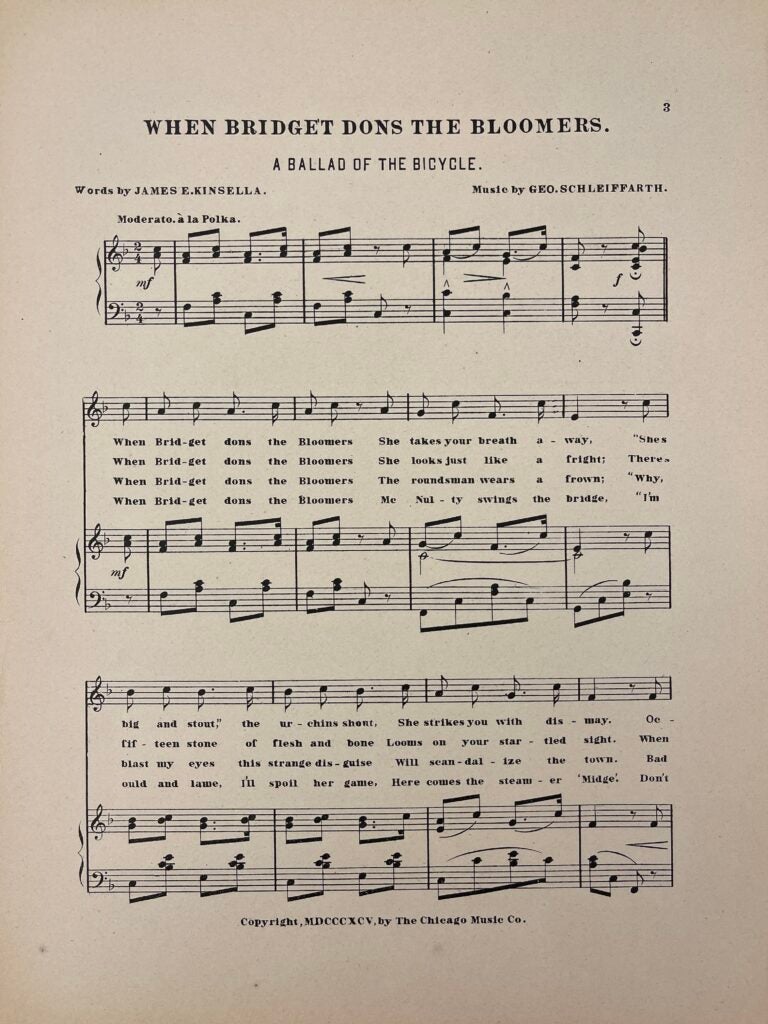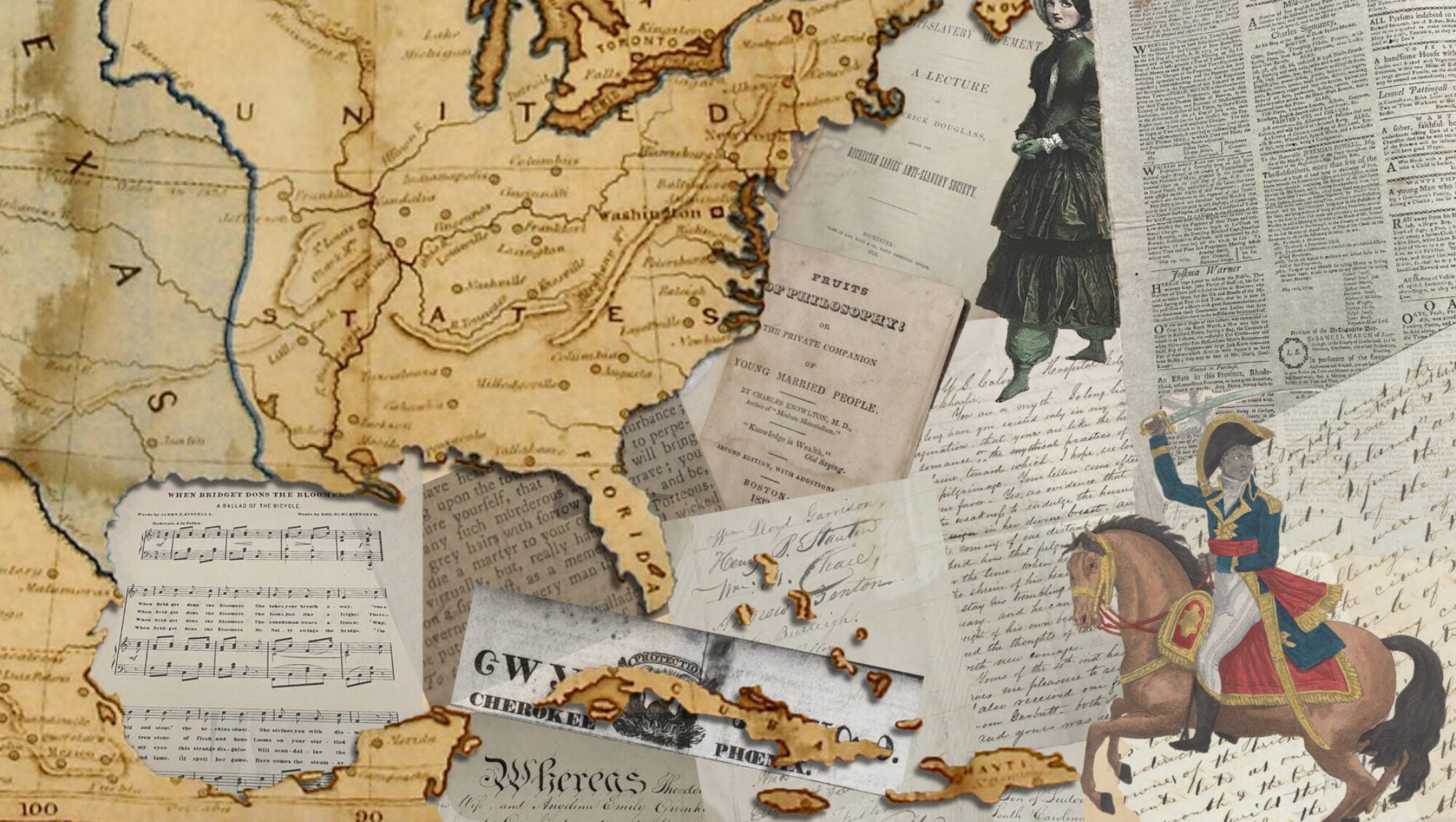by Zachary Geyer

When most people remember the push for women’s rights in the United States, they likely think of the women’s suffrage movement, Susan B. Anthony, and Seneca Falls. While these are well-known events and large actors in the history of women’s resistance, the smaller, community-driven acts of resistance are often overlooked. Primary sources that provide a window into daily life can help us understand these moments and decisions. Music is often seen as something that is made for entertainment and is just in the background, however, it has had a dual purpose. These two pieces of sheet music from the nineteenth century reveal how the circulation of music played an important role in women’s resistance to patriarchal gender norms. The sheet music also shows how the fight for gender equality angered the minds of oppressors.
The first piece of music, titled “The Bloomer Schottisch’” by William Dressler, depicts the bloomer costume.[1] The bloomer costume consisted of a light, half-length dress and pants and was used to promote women’s health and freedom, according to early women’s rights activist Elizabeth Cady Stanton.[2] One of the important aspects of the feminist movement was the fight for women to change their dress to be freer and closer to men’s clothing. Beginning in the early 1800s, some women began to wear the bloomer costume as an act of resistance against traditional gender norms that oppressed them both psychologically and physically. Supporters of this Bloomer Movement spread awareness through music. Women were inspired to resist patriarchal society through the bloomer costume due to the printing and circulation of this sheet music.
The front cover of “The Bloomer Schottisch” depicts a woman wearing a dark green bloomer costume front and center on the page. This type of illustration is not typically found on sheet music and would draw many readers in. From there, people would be drawn to the dedication text, which reads: “dedicated to Mrs. Bloomer and the ladies in favor of the bloomer costume.” By using the words “dedicated to,” Dressler shows that this music is associated with the Bloomer Movement. Thus, even just listening, buying, or enjoying this piece of music would be acts of resistance. Historian Ellen Hartigan-O’Connor in her book, The Ties That Buy: Women and Commerce in Revolutionary America, has explored women’s opportunities to engage in markets and shopping culture in the mid-eighteenth century. She argues that discussion and gossip while shopping enabled women to spread ideas of equality.[3] “The Bloomer Schottisch” should be seen as a type of purchasable music that helped spread such ideas; examining or buying this music would often lead to discussions among women who were previously unexposed to ideas of equal dress. Some women who wore bloomer costumes or supported the movement might only have stumbled upon it through purchasing music like this, highlighting the essential part music played in this movement.

The art of music was also used to depict the progress of women’s resistance against gender norms in their male-dominated society. The second piece, titled “When Bridget Dons the Bloomers” by James Kinsella, describes the reactions to a woman wearing bloomers walking down the street. The lyrics are satirical, and one of the key lines reads “when Bridget dons the bloomers…she strikes you with dismay.” The word “dismay” illustrates the effect the Bloomer Movement had on those in control in a patriarchal society– men. This source reveals that men found this new way of dress both infuriating and emasculating. Bloomers gave men less control over a woman’s body and their freedom, illustrating how women used this type of dress to resist long-standing gender inequities in the United States.
Marion Tinling’s article, “Bloomerism Comes to California,” further helps us understand the success of the bloomer costume at challenging gender norms. Images of Amelia Bloomer, the namesource of the movement, appeared in newspapers like the London Times and spread across the U.S. from New York to California. Bloomer and her Movement led some clergymen to declare the outfit to be “favoring free love and breaking up the home.”[4] A movement could never invite such widespread anger if it was not an integral part of the fight for women’s equality and the disassembly of gender norms.
The Bloomer Movement was a catalyst for change in regards to the movement for women’s rights in America, which is ongoing today. Music and other everyday media helped women spread ideas about overhauling the oppressive society they lived in for so long. Remembering this history is extremely important because it illuminates the role that small things, like changing an outfit, played in the advancement of equality and rights for all.
Citations
[1] “The Bloomer Schottisch,” 1851 and “When Bridget Dons the Bloomers,” 1895, William L. Clements Library, University of Michigan.
[2] “Elizabeth Cady Stanton on ‘the Bloomer costume’ in her ‘Reminiscences,’ published in History of Woman Suffrage, volume I, 1881, in Sally Roesch Wagner, ed., The Women’s Suffrage Movement (New York: Penguin Books, 2019), 110-12.
[3] Ellen Hartigan-O’Connor, The Ties That Buy: Women and Commerce in Revolutionary America (University of Pennsylvania Press, 2011).
[4] Marion Tinling, “Bloomerism Comes to California” California History 61, no. 1 (1982): 4-7.

